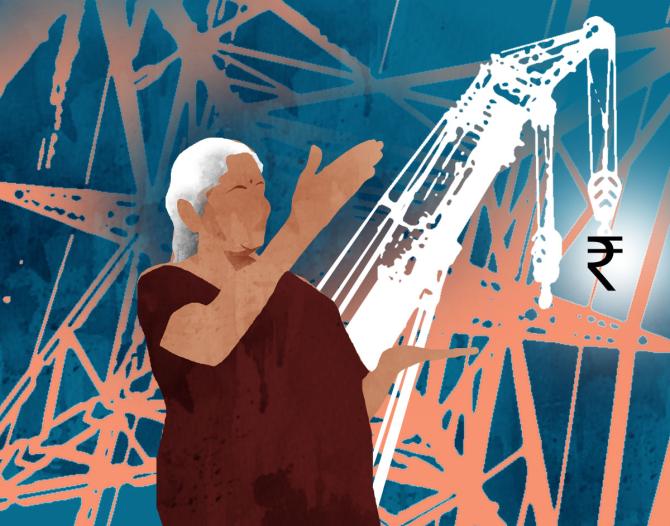Why India’s Growth Rate Has Suffered

‘80% of the rural and urban population don’t have enough purchasing power.’
Recently released data on India’s economic growth by the National Statistical Office revealed that India’s economic growth decelerated to 4.4% in the October-December 2022 quarter.
Former RBI governor Dr G Raghuram Rajan warned that India was dangerously close to the Hindu rate of growth of 4%.
Are we really going in that direction? Shobha Warrier/Rediff.com asks Dr Surajit Das, assistant professor of economics, Jawaharlal Nehru University.
“There is not enough stimulus in the economy to ensure higher growth and employment,” Dr Das explains in the first of a two-part interview:
Raghuram Rajan said India was dangerously close to the Hindu rate of growth due to not much private investment, high interest rates and also slowing global growth.
Do you agree with this statement especially the Hindu rate of growth part?
It was Dr Raj Krishna who coined the term Hindu rate of growth in 1978.
It is an average growth rate of 3.5%-4% which the Indian economy experienced for a long time; from Independence till 1980.
After liberalisation, the growth rate increased and in the 1990s, we experienced around 6%-6.5% growth per annum on an average.
2003-2007 was the high growth period when our average growth rate was 8%.
Then it came down a little bit after the financial crisis of 2008 to around 6.5% and again it rose to 6.5%-7%.
In the recent past, before the lockdown itself, the growth rate had come down to 4%.
Many people are of the opinion that after the implementation of GST and demonetisation, the growth rate suffered a lot.
You feel the main reason was both demonetisation and the implementation of GST affected MSMEs badly?
Yes. In fact, while big businesses made huge profit during the lockdown and even before, investment in the small and medium scale enterprises in proportion to the GDP declined.
As a result, the non-food credit offtake from commercial banks in proportion to GDP in India was coming down even before the lockdown.
That was happening because in almost all the industries, there was excess capacity as they were not operating at full capacity level output.
It means they were actually producing less than their potential.
It was because there was lack of demand in the market for the commodities they were producing.
So, why would they make new investment, which would be an addition to the stock of capital, when the existing stock of capital was not optimally utilised?
And especially in manufacturing, there was no investment happening.
For GDP to grow, you can either increase government expenditure or ensure the export minus import growth at a higher rate.
But because of the global situation, the possibility of export led growth is dim.
In fact, the export growth rate is one of the lowest now.
At the same time, we are dependent on import of oil and many other items.
Though we export gems and jewellery, the raw material comes from South Africa.
They get polished in Surat and Karol Bagh (in Delhi) before we export them to the Western market.
While the export growth rate is not that high, the import rate has gone up because of high oil price.
So, the export minus import growth, which is net export, is not growing at a very fast rate.
It means, there is not enough stimulus in the economy to ensure higher growth and employment.
The only option available to this government is to increase expenditure.
The government increased capital expenditure in this year’s Budget by 30% which the finance minister said would give confidence to private investors. Do you think so?
Yes, it is true that capital expenditure in proportion to GDP has been increased substantially.
In my opinion, the capital expenditure net of divestment should have some positive impact. Divestment is like negative capital expenditure.
The problem is, it has been done at the cost of revenue expenditure.
In fact, the total government expenditure to GDP actually came down.
That’s because when you reduced revenue expenditure, the total expenditure to GDP ratio came down, even though you have increased capital expenditure.
Most of the expenditure for the social sectors like health, education, MNERGA, subsidies for cooking gas, food and fertiliser contribute revenue expenditure.
If you reduce revenue expenditure when people do not have enough purchasing power, the demand in the market will come down affecting growth negatively.
If you want to reduce unemployment and increase growth rate, you don’t reduce revenue expenditure.
You mean, what the finance minister proposed in the Budget will not have a positive impact on the economy?
See, if I am an investor, I have to borrow money from a commercial bank or from some financial non-banking financial institution.
I borrow at 12%-13% per annum and invest. But if the expected rate of return is not higher than the rate of interest, it is a loss-making venture for me.
Unless the expected rate of return is higher than the cost of borrowing, no investor will take the risk.
Until people have purchasing power, until there is enough demand for goods and services, nobody will have the confidence to invest.
Do you feel there is not much money in the hands of consumers and that is the reason why there is no demand in the market?
That is the main reason why there is no demand in the market.
As there is no consumption expenditure data available after 2011-2012, what I did was, I took the 2011-2012 numbers and converted them into 2019-2020 prices.
And I came to the conclusion that 80% of our population, for all practical purposes, is still poor.
The total monthly family consumption expenditure, not per capita, of a rural family of four is below Rs 12,500 per month.
And for 80% of urban families, the family consumption expenditure is lower than Rs 23,000 per month in 2019-2020 prices.
It means 80% of the rural and urban population don’t have enough purchasing power.
And 22% of the labour force did not get any wages before the lockdown. During the lockdown, the number went up. So many people were working with zero income.
Feature Presentation: Aslam Hunani/Rediff.com
Source: Read Full Article


